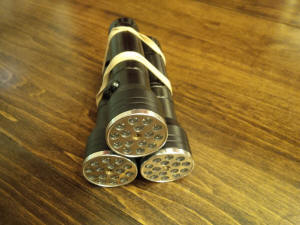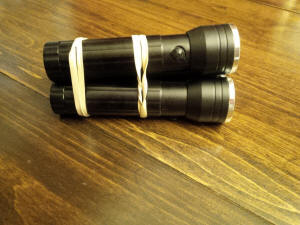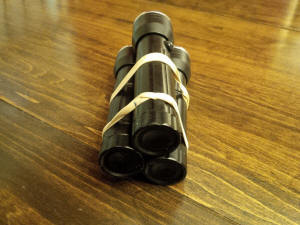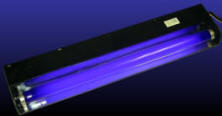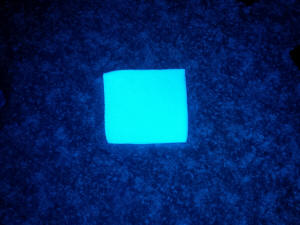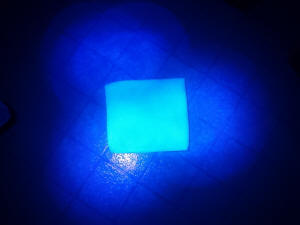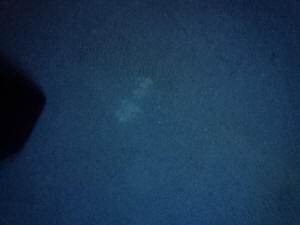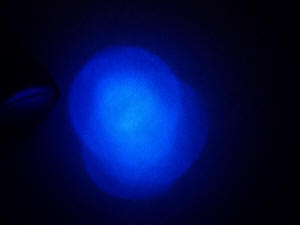| DooDoo Voodoo Blacklights We used to offer two types of blacklights. We have long sold a plug-in type, made by GE, that features an 18" bulb and which we feel does a better job of showing organic contamination than other brands do. We also used to sell a small, handheld, cordless flashlight-type unit that used long-lasting LEDs and also featured a regular flashlight function and a laser pointer function (excellent for using to play with your cats). I bought and tried a number of these types of corded and handheld units before deciding which Four On The Floor should sell. A customer asked how the two types compare, so I fired each of them up, went to the darkest rooms in our house and shot some photos that I think you'll find helpful. The quality of the light put out by the two units is different. Because the plug-in unit uses an 18" bulb, the light it emits is very even, with no hotspots. The cordless flashlight's light is brighter overall, but does exhibit some hotspots, as you'll see in the photos below. The plug-in unit's light is, I think, a bit better at showing organic contamination, but you can absolutely ascertain contamination under the handheld flashlight's light, too. I could assess a room using either unit and feel confident in my results. I shot photos of a white, folded-up towel I laid on some nice vinyl flooring. I also shot photos of a spot where our rescued, special-needs dog had peed on the carpet in our treadmill room. I had previously treated this area with DooDoo Voodoo, so its fluorescence (glow under the blacklight) is reduced from what it would be if the spot were fresh and untreated. Note that when I turned on all three cordless flashlights, which I had ganged together with rubber bands, the total amount of light being emitted was too much, so I turned two of them off. In the photo taken in the treadmill room, you'll see rings of light on the floor and swear that I had all three flashlights on, but I did not. What you see is from ONE of the cordless, handheld units. The rings of light can sort of make it a wee bit trickier to assess your organic contamination, but by moving the handheld unit around a bit, you can find the "sweet spot" in which you can best see the contamination. The cordless flashlights' brightness could be a plus for those of you unable to get the room dark enough to really check around for contamination. I'd say (and this is a subjective opinion), that though its output is a bit dimmer, the GE plug-in unit might do a wee bit better job of showing you the contrast between the contaminated areas and the uncontaminated areas. If you have electrical outlets easily accessible and can devote a 25' extension cord to it, I advise that you get the GE plug-in unit, as I trust and prefer the wavelength of its emitted UV light. If you do not have electrical outlets readily available, you cannot get the room(s) totally dark or you prefer the convenience of the handheld unit, the little handheld unit(s) might be useful to you. None of the photos has been retouched in any way, only resized and optimized for web viewing. Check out the photos and form your own opinion. Click on each photo to see the larger version.
|
